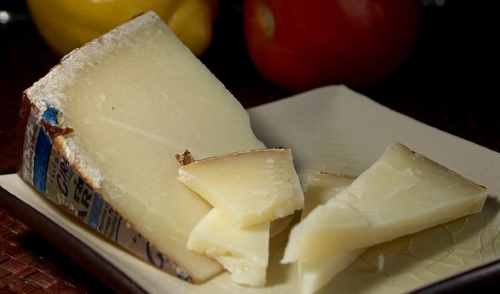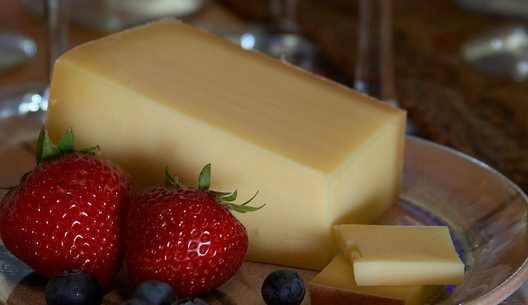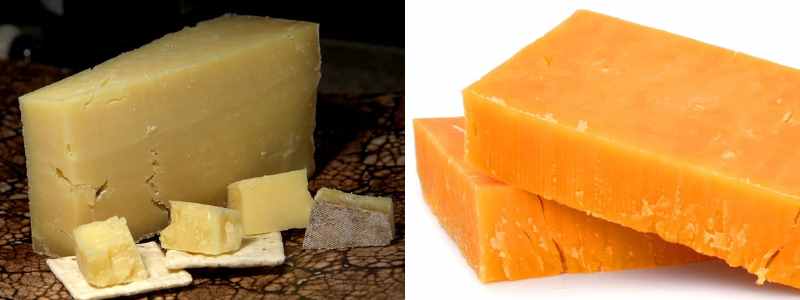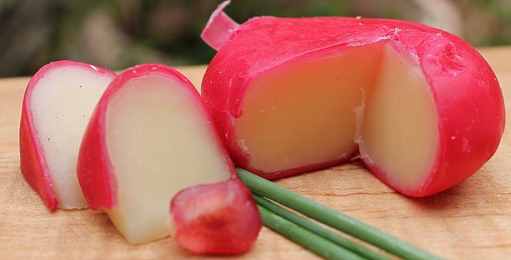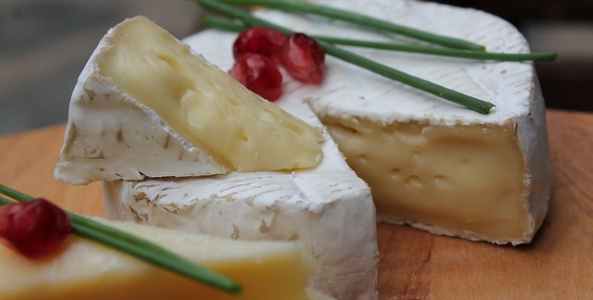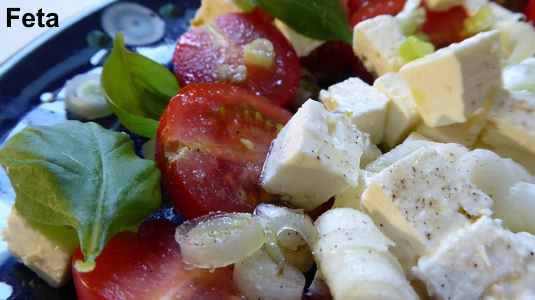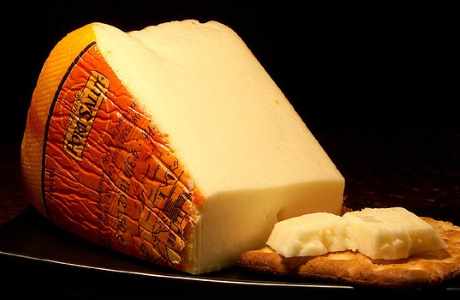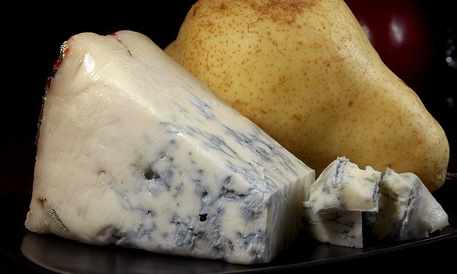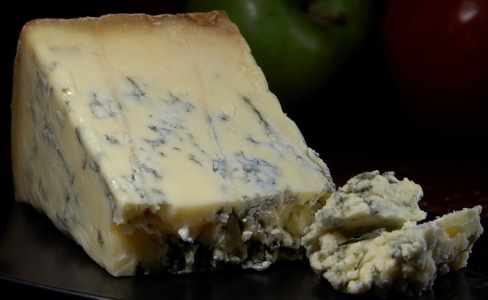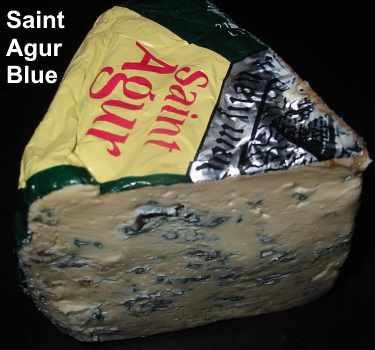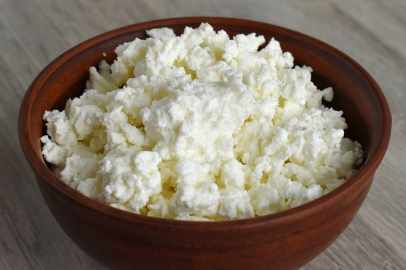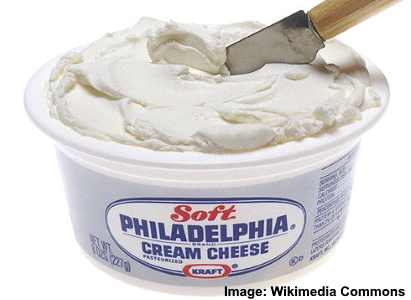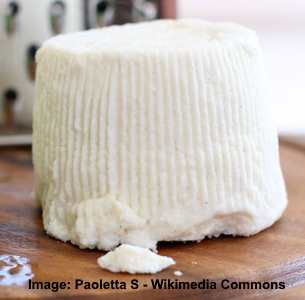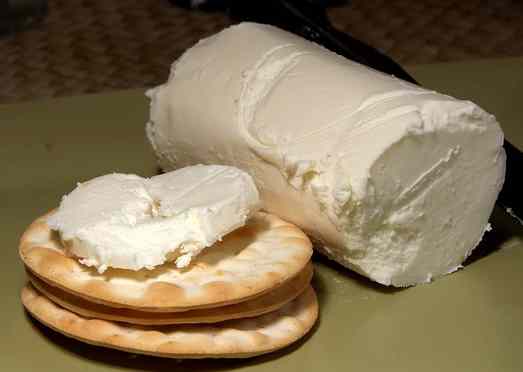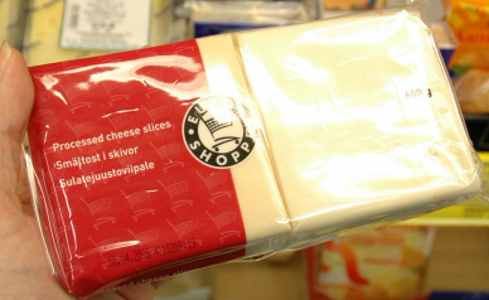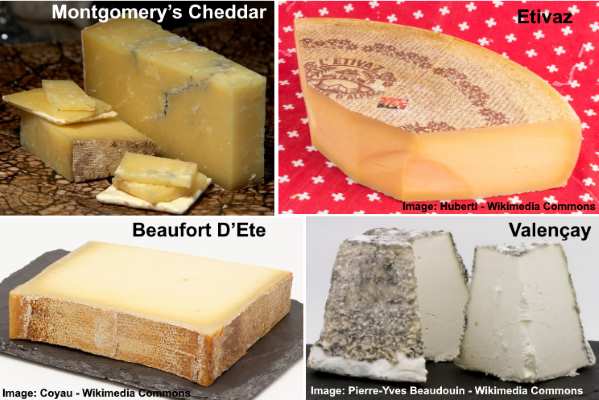The Tastiest and Most Exciting Types of Cheese You Didn’t Know About
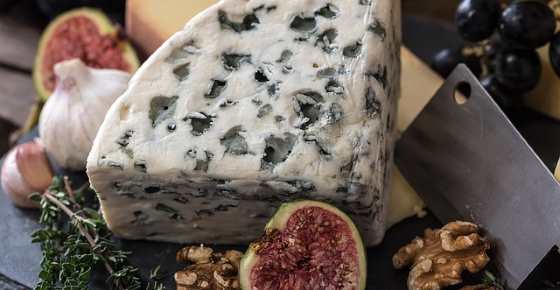
Cheese is one of the most popular types of dairy foods on the planet. There are many varieties of cheese to choose from. There are tasty hard cheeses such as parmesan or grana-padano, soft cheeses such as mozzarella, burrata, or feta cheese, and soft-ripened cheeses such as Camembert. The list of cheeses includes popular types such as Cheddar, Gouda, and Colby that are enjoyed by millions of people every day.
Although all varieties of cheese use common ingredients, the way cheese is processed determines the final texture, taste, and look of the cheese. Some types of cheese taste mild and buttery whereas some kinds of hard cheese have a sharp, nutty flavors.
Types of Cheese (Cheese Categories and Examples)
Although there are hundreds of varieties of cheese, the main types of cheese are broken down into 6 categories:
- Hard cheese. The list of hard cheeses includes popular types such as Parmesan, Pecorino, and Grana-padano cheese
- Firm cheese (semi-hard cheese). This cheese category includes cheeses like Cheddar, Gouda, Provolone, and Marble cheese
- Blue mold cheese such as Roquefort, Gorgonzola, Stilton, and Danish Blue (Danablu) cheese
- Soft cheese. This cheese category includes a wide range of cheeses such as Brie, Camembert, Mozzarella, Burrata, and Feta cheese
- Fresh cheese such as Cottage cheese, Cream cheese and Queso fresco
- Goat’s cheese
Cheese is a Delicious Type of Food
Cheese is high in saturated fat which makes many people shy away from this delicious type of food. However, there are healthy options to choose from when it comes to picking your favorite type of cheese. It is also good to remember that cheese is a good source of protein, calcium, and other nutrients.
In this article, you will learn about the many different types of cheese and which are the healthy options to choose from.
Types of Hard Cheese (With Pictures and Names): List of Hard Cheeses
Hard cheese is a very firm cheese that has a low moisture content and rich, deep, sometimes nutty, flavors.
The hard cheese category can be divided into two sub-categories: hard cheeses (such as Grana-Padano or Parmesan), and semi-hard cheeses (such as Cheddar or Gouda).
To make hard cheese, most of the whey is drained from the curd. The cheese is then formed into large round cylinder called a truckle. During the aging process, which can last between 2 and 36 months, a thick rind develops on the cheese cylinder.
It is also thanks to the aging process that more moisture evaporates and the cheese flavor intensifies as the cheese cylinder hardens.
For healthier options of hard cheeses, look for varieties that are low in fat and sodium.
Here is a short list of different types of hard cheese:
Parmesan cheese (Parmigiano-Reggiano)
Parmesan is one of the most popular types of hard cheeses and is often used in Italian dishes and thinly sliced on Caesar salads.
Parmigiano-Reggiano refers to the type of parmesan cheese that comes from the provinces of Parma, Reggio, and Bologna in Italy. This light-yellow hard cheese has been called the “King of Cheeses” and has a strong nutty taste with a slightly gritty texture.
A 1-oz. serving of hard parmesan cheese contains 7 grams of fat, 10 g of protein, and 336 mg of calcium. This small serving gives you 33% of your recommended daily intake (RDI) of calcium. (1)
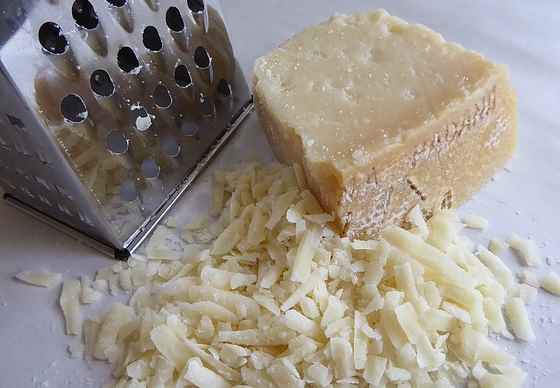
Parmigiano-Reggiano or Parmesan is an Italian hard cheese with gritty texture and fruity nutty taste
Pecorino Romano
Pecorino Romano is an Italian hard cheese variety made from sheep’s milk that has a saltier taste than parmesan. The Romans started making this type of cheese over 2,000 years ago, making it one of the oldest types of cheeses in the world.
The original Pecorino Romano has a much nuttier and more intense flavor than “Romano” cheeses made from cow’s milk. People describe the flavor of this cheese variety as buttery with a salty sharp taste.
A 1-oz. serving of Pecorino contains 9 g of fat, 8 g of protein, and 200 mg of calcium. So, if you are looking for a healthier option cheese, parmesan is slightly healthier. Or, you could look for low-fat, low-sodium varieties of Romano cheese. (2)
Appenzeller
Appenzeller is a type of Swiss hard cheese that is made from cow’s milk and is aged between 3 and 6 months.
Like with many kinds of Swiss cheese, Appenzeller has small holes that form during the aging process. Appenzeller that has been aged for 3 months has a mild flavor, whereas the type of cheese aged for more than 6 months has a pungent aroma and tangy taste.
This hard Swiss cheese has a similar nutritional value to other hard cheeses in this section.
Other types of hard cheese: list of hard cheeses
The list of hard cheeses also includes popular varieties such as:
- Manchego is a type of hard cheese from Spain made from sheep’s milk that has a sweet nutty taste.
- Grana-Padano is a type of Italian hard cheese with a texture similar to Parmigiano-Reggiano but with a milder flavor.
- Gruyère is a delicious type of hard Swiss cheese that melts well and is often used in toasted sandwiches and French soups. This is a popular Swiss hard cheese made from creamy cow’s milk and is ripened for many months.

Types of hard cheese: Manchego cheese from Spain, Grana-Padano and Gruyère which is a delicious Swiss cheese
Types of Firm Cheese (Medium or Semi-Hard Cheese)
Cheese that has a medium-hard or semi-firm texture includes some of the most popular cheeses in the world.
Nearly all varieties of firm cheese have a good balance of texture, taste, and moisture. Most firm cheeses are aged between 1 month and 6 months. As with the hard cheese varieties, the longer they are aged for, the more intense the flavors become.
Some popular types of medium-hard cheese like Gouda and Edam are aged in a red rind. Other semi-hard cheeses like Cheddar or Red Leicester melt well and have a slightly crumbly texture.
Cheddar cheese
Cheddar cheese is the most famous English cheese and it has also been rated as the world’s most popular cheese.
Cheddar is made in the English town of the same name and is aged in the Cheddar Gorge caves. Natural colors such as annatto or paprika are added to Cheddar to give it a distinct orange color. However, Cheddar also comes in pale yellow or medium-yellow colors.
There are almost as many varieties of Cheddar cheese as there are cheeses.
As with all varieties of cheese, Cheddar contains a good amount of calcium with a 1-oz. serving containing 20% of your calcium RDI.
If you love the taste of this popular type of cheese, but want healthier options, then you can buy low-fat or even zero-fat Cheddar cheese.
The red-colored cheese, Red Leicester, is sometimes marketed as Red Cheddar.
Gouda cheese
Cheese with a red rind is most likely Gouda which is a popular semi-firm mild, yellow cheese, originating from the Netherlands.
There are various ways to make this mild-tasting cheese. Cheese-makers use goat’s, cow’s, or sheep’s milk to create their cheese that has a sweet and nutty taste. Gouda is matured in a red rind wax from anywhere between a month and 3 years.
The aging process also affects the color of Gouda cheese. Younger types of cheese are light yellow, whereas aged varieties are dark yellow and have a more intense taste.
Marble cheese
Marble cheese gets its name from the white and orange marbling effect in this cheese.
The orange and white cheese is produced using the curds of orange Cheddar and white Cheddar. In the U.S., the orange/white cheese called Colby-Jack and is made using a similar process.
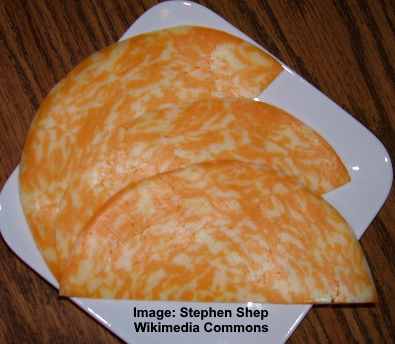
Marble cheese is a mild tasting, hard, white and orange cheese made from two varieties of Cheddar cheese
Other types of medium-hard and semi-hard cheeses
The list of semi-hard cheeses also includes popular varieties such as:
- Colby cheese is a cheddar-like cheese that is made in the U.S. Colby cheese has a softer texture and milder flavor compared to English Cheddar cheese.
- Emmental cheese from Switzerland with its light-yellow color and mild nutty taste is famous for holes that develop during the aging process.
- Wensleydale is an English cheese which is a good example of a delicious firm cheese with a crumbly texture. Wensleydale cheese often has fruit such as cranberries or dried apricots added which also give this pale-colored cheese an interesting look.
- Red Leicester is a very popular red English cheese that has a crumbly texture. Red Leicester also develops a red rind on the cheese as it matures. Aged Leicester cheese (also called Leicestershire cheese) has a nutty taste.
- Halloumi cheese originates from Cyprus and is a good type of cheese for grilling or frying. It has quite a salty flavor and is an excellent source of calcium. It’s a semi-hard cheese that can be made from cow, sheep or goat’s cheese.
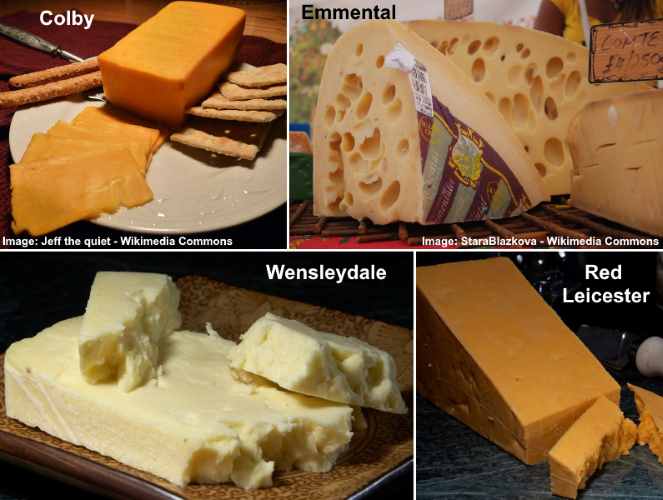
Types of medium-hard and semi-hard cheeses: Emmental cheese, Colby cheese, Wensleydale cheese, Red Leicester cheese
Soft Cheese Varieties
Types of soft cheese are usually defined by their creamy texture and delicious buttery taste. Soft cheeses are usually not used for cooking.
Many types of soft cheese contain less fat than firm varieties of cheese such as Cheddar or Edam (which can have up to 55% fat content).
In general, soft cheese has a milder flavor than some of the pungent hard cheeses or blue mold cheeses.
Let’s look at two of the most popular types of soft cheese – Brie and Camembert.
Brie
Brie is one of the most-loved type of French cheese made from cow’s milk and has a mild taste with earthy hints.
Brie is ripened by using a cheese culture during the processing and then being aged for 4 or 5 weeks. This helps to give Brie its distinctive white edible mold rind which also helps keep the shape of this soft cheese.
Usually, most cheese boards include Brie because it goes well with grapes, fruits, ham, and wine.
Like with many full-fat cheeses, Brie is a good source of protein, calcium, and other nutrients.
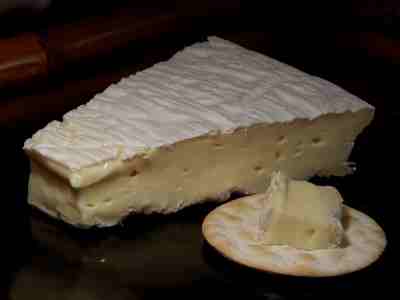
Brie is the best known French cheese. It is a soft, creamy and smooth cheese made from cow’s milk. It has pale color with a slight grayish tinge under a rind of white mold
Camembert
Camembert is a well-known type of soft French cheese which is traditionally made in the French region of Normandy.
One of the differences between Camembert and Brie is that Camembert is shaped into smaller flat cylinders than Brie. As Camembert ripens, it develops a thick rind and has a more pungent aroma than Brie.
Camembert is a delicious cheese to eat warm. Baked Camembert rounds have a creamy texture that oozes soft and creamy cheese when you cut into it. Camembert is also in the category of “white mold cheese.”
Other types of soft cheese
Some other popular types of soft cheese can include the following:
- Saint-Damase is a soft-ripened cheese that has a light creamy texture and a distinct woody aroma. This is traditionally made in Canada.
- Feta cheese is a soft white crumbly cheese made from goat’s or sheep milk and traditionally part of Greek cuisine.
Semi-Soft Types of Cheese (With Pictures and Names)
It can be difficult to distinguish between cheese varieties that are classed as “soft cheese” or “semi-soft” cheese.
Generally, types of cheese that are described as semi-soft are somewhere between firm cheeses such as Cheddar and soft cheeses such as Brie.
Mozzarella cheese
Mozzarella is probably one of the most popular types of cheese in the world as it is commonly used on most pizzas and lasagna.
The traditional method to make Mozzarella cheese is using buffalo milk. This gives the soft white cheese a tangy, creamy taste. When compared to the cow milk variety, Mozzarella from cow’s milk has less flavor and a sweeter taste than true buffalo Mozzarella.
One feature about Mozzarella is that it melts well and becomes very “stretchy.”
You can also eat this delicious semi-soft cheese on its own or together with fresh tomatoes, a little olive oil, and fresh herbs.
Some producers also use sheep’s milk or goat’s milk to create fresh Mozzarella cheese. The Mozzarella balls are sold in packets of brine or whey water to keep them fresh and hold their shape.
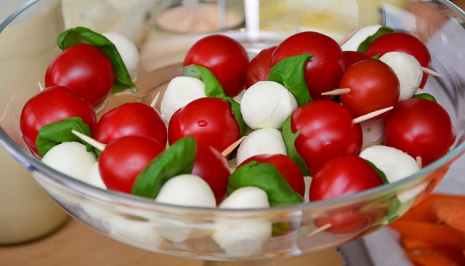
Mozzarella is a traditional fresh or unripened Italian cheese made from buffalo’s milk. It has milky, tender, and mild taste.
Havarti cheese
Havarti is a type of mild-tasting semi-soft cheese from Denmark that has a creamy consistency and light-yellow color.
Havarti is also sold as an aged cheese that still retains its smooth buttery consistency but has a sharper, salty flavor.
When it comes to choosing a healthy cheese option, Havarti cheese is similar to cheddar cheese. Eating it in reasonable amounts can give you plenty of protein and calcium. You just need to watch portions as a 1-oz. serving contains 6.5 grams of saturated fat. (3)
You can also opt for a healthier type of Havarti called Light Havarti cheese which has a much lower fat content.

Havarti or cream Havarti is a semi-soft, mild and creamy Danish cheese. This cheese is made using cow’s milk and used as a table cheese
Port Salut
Port Salut is a type of semi-soft cow’s milk cheese that originates in France and has a distinct orange-colored rind covering a light-yellow cheese.
Unlike other cheeses in this category which have very mild aromas, Port Salut is a matured cheese with a strong aroma. However, the taste is very mild in comparison to the aroma and many cheese-lovers enjoy it for this.
Types of Blue Mold Cheese (With Pictures and Names)
When it comes to choosing delicious cheese varieties, none can divide opinion as much as blue mold type of cheeses.
Blue mold cheese was discovered by accident when cheese was left behind in a cave near the village of Roquefort in France. The naturally growing mold (Penicillium roqueforti) in the cave had infested the cheese. Thankfully, the cheese was still edible and it had developed a sharp, tangy taste.
Today, most moldy blue cheeses use the same type of mold to give flavor and color to the fancy cheese.
This type of cheese with its white and blue color and pungent aromas and flavor is an acquired taste for many people. Most blue mold cheeses have a crumbly texture and a buttery consistency. The taste of “moldy” cheese can range from mild and gentle to sharp and tangy.
It takes between 3 and 6 months for the cheese wheels to ripen, and skewers are inserted to allow the mold to turn the cheese blue.
Although you may be concerned about eating “moldy” cheese, there is some evidence that it may have health benefits. One study found that mold in blue cheeses may improve cardiovascular health and inhibit cholesterol forming. (4)
Roquefort
Roquefort is the original blue mold cheese and is held in high regard by the French as a delicious cheese. In fact, French people refer to Roquefort as the “king of cheese.”
To be officially called Roquefort, the cheese has to be made from ewe’s milk and then ripened in the caves of Roquefort-Sur-Soulzon.
As with most blue cheeses, Roquefort is a type of cheese with an intense earthy flavor that can be sharp and tangy. This semi-hard cheese also crumbles well and can be eaten on its own, with fruit, or used in recipes.
Gorgonzola
Gorgonzola is a fine example of crumbly Italian blue mold cheese with a light blue and white marbling effect.
When it comes to flavor and aroma, Gorgonzola really packs a punch.
The strongest-tasting type of Gorgonzola is Piccante Gorgonzola that is aged for between 6 and 12 months. This blue cheese has a crumbly texture and a pungent taste. Due to its intense flavor, the best way to use this type of blue mold cheese is along with other foods.
Dolce Gorgonzola is a milder variety of this mold cheese. It has a soft texture and is pleasant to eat along with nuts, grapes, or honey.
Stilton
Stilton is one of the best examples of an English type of blue mold cheese and comes from a town of the same name.
Compared to other blue cheeses, Stilton has a milder flavor. However, it still retains a crumbly texture and has a distinct creamy taste of earthy mushrooms.
Danish Blue
Danish Blue is the most famous blue mold cheese from Denmark. It is made similar to Roquefort but uses cow’s milk instead of sheep’s milk. This results in a strong-tasting crumbly cheese that has a white creamy color with streaks of blue running through it.
Compared to other blue mold cheeses in this category, Danish Blue has a milder flavor than Gorgonzola but a sharper taste than Roquefort.
Crumbling Danish Blue on salads or enjoying it on crackers are the most popular ways to use this aromatic type of cheese.
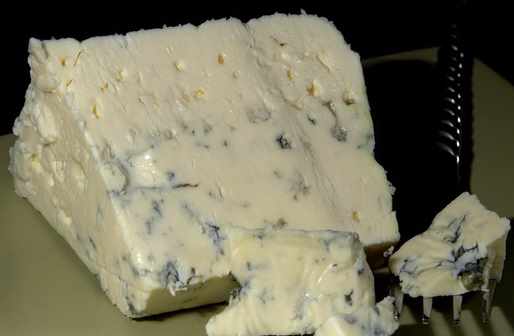
Danish Blue Cheese (also known as Danablu) is a strong, semi-soft blue-veined cheese made from cow’s milk.
Other types of blue mold cheese
- Saint Agur Blue is a creamy blue cheese from France that has a soft, yet spicy taste. This type of cheese can be used as a spread and it also melts well.
- Oregon Blue is produced in the U.S. and is similar to Roquefort cheese. The Rogue Creamery that produces this cheese also make Oregonzola – a crumbly cheese similar to Gorgonzola.
White Mold Cheese
Most types of cheese in the “White Mold” category are also soft cheeses. Brie and Camembert are the most famous kinds of white mold cheese.
Varieties of Fresh Cheese (With Pictures and Names)
Fresh cheese is produced with the same basic ingredients as hard cheese and soft cheese.
The difference with fresh cheese is that they are not aged or ripened as other varieties of cheese are. This cheese-making process results in a white cheese with a mild taste.
Some types of fresh cheese have a smooth and creamy texture that makes it easy to spread on crackers, bagels, or toast. Other varieties of fresh cheese such as cottage cheese have a grainy texture with less fat content.
Cottage cheese
Cottage cheese is a fine example of a naturally low-fat healthy cheese that is great to eat if you want to lose weight.
Cottage cheese may be one of the healthiest cheese you can eat. For example, one type of low-fat cottage cheese only contains 1 gram of fat in a 4-oz. (113 g) serving. This serving has just 72 calories and contains 12 g of protein, which is one-quarter of your RDI of protein. (5)
Cottage cheese is also a very versatile type of cheese and can be added to salads, yogurts, pancakes, and baked foods.
Cream cheese
Cream cheese is made by combining milk and cream to create a soft, spreadable cheese that has a rich creamy flavor.
Cream cheese became popular type of cheese when dairy farms in Philadelphia started to produce this white fresh cheese. In fact, cream cheese is often referred to as “Philadelphia cheese.”
Cream cheese is commonly used in sandwiches, spread on bagels, used as a dip and, of course, the main ingredient in cheesecake.
When it comes to healthy cheese choices, cream cheese may not be one of the best. For example, a tablespoon of cream cheese (14.5 g) contains nearly 5 grams of fat and less than a gram of protein. (6)
Of course, you can also choose a low-fat variety of cream cheese or even a fat-free version.
Ricotta
Another popular fresh cheese is Ricotta which has a creamy texture and is a healthy type of cheese. Ricotta can be made from cow’s, sheep’s, or buffalo’s milk.
Ricotta is produced by heating whey and then coagulating it to form a crumbly-looking type of cheese. Some types of Ricotta are also baked, fermented, or salted to enhance taste and texture.
One of the reasons why Ricotta has become such a favorite fresh cheese is that it is packed with protein. For example, ½ a cup of ricotta (124 g) made from part skim milk contains 14 grams of protein, which is 28% of your RDI. The serving size has 171 calories and just under 10 grams of fat. However, it also contains a lot of calcium, phosphorus, and zinc. (7)
Other types of fresh cheese
- Mascarpone is another fresh cheese from Italy that has a soft creamy texture similar to cream cheese. Mascarpone is used in many Italian desserts such as tiramisu and cheesecake.
- Burrata is similar to mozzarella but it oozes soft creamy cheese when sliced open.
- Feta cheese.
- Mozzarella.
Popular Varieties of Goat Cheese
Goat cheese varieties are popular in Mediterranean countries. Most types of goat cheeses have sharp tangy taste and they come in varying textures.
Some types of goat’s cheese are hard and firm such as some varieties of Chèvre. Others are soft and crumbly such as feta cheese (which is also a type of fresh cheese). Still, goat’s cheese comes also in blue mold varieties with characteristic earthy flavors.
Most types of goat’s cheese tend to be low in lactose compared to cow’s milk and contain enzymes that help to improve good intestinal bacteria. (8, 9)
Goat milk feta cheese
One of the most popular Greek cheeses, Feta cheese, has a creamy, crumbly texture that is used in Greek salads, grilled, or marinated in olive oil.
People describe the taste of feta cheese as a delicious tangy cheese with salty overtones.
Goat milk feta cheese is a good option for people who can’t eat cheese made from cow’s milk. Although 100 g of feta cheese contains 21 g of fat, only 14 grams is saturated fat. This means that feta cheese is a healthier option than many aged hard cheeses. (10)
Chèvre
Chèvre describes popular types of French firm cheeses made from goat’s milk. There are a number of varieties of Chèvre depending on the aging process, molds used, and rinds on the cheese cylinders.
As with most goat’s cheese, varieties of Chèvre have sharp tangy tastes with pungent aromas.
Other types of goat cheese
- Blue goat cheese is similar to other types of blue mold cheeses with a crumbly texture, a white and blue marbling color, and tastes of earthy mushrooms.
- Goat Milk Gouda is a take on the classic Holland cheese that has the taste of goat’s cheese but the texture of Gouda.
- Goat’s brie is made in a similar way to traditional French Brie but has a more subtle and refreshing flavor.
- Garrotxa is a hard cheese variety from Spain that doesn’t taste as strong as other goat’s cheese. Garratoxa is covered with a light yellow rind that covers a white/yellow cheese that tastes delicious.
Types of Processed Cheese
Types of processed cheese include packs of individual cheese slices and spreadable cheese that are convenient to use.
Processed cheese is made by combining cheese curds with other ingredients such as oil, sugar, and salt. Varieties of processed cheese can include various types of Cheddar cheese, Red Leicester, Gouda, Edam, Colby, or Gruyère.
However, processed cheese is generally a far inferior product to natural cheese as it often includes unhealthy additives, flavoring, and emulsifiers.
The best types of cheese to choose are generally natural cheeses, not the highly processed varieties.
Varieties of Fancy Cheeses
There are literally hundreds of varieties of cheeses to choose from if you are looking for a fancy cheese.
Some types of fancy cheeses could be well-aged variations of traditional cheeses. For example, some types of Cheddar or Gouda cheese have been aged for 5 years or even longer. This gives the cheese a firmer texture and more intense flavor.
Some fine examples of fancy cheese include the following list:
- Montgomery’s Cheddar has been called the “King of English Cheddars” and has a rustic-looking rind with a light-yellow intensely-flavored cheese.
- Etivaz is a hard Swiss cheese said to be based on the original recipe for Gruyère.
- Beaufort D’Ete is a fancy hard cheese from France that is pale yellow and has a strong pungent aroma.
- Valençay is a white French goat’s cheese that has a moldy grey rind. This fresh cheese has a fresh, citrus-like taste with aged varieties having strong tastes similar to other goat’s cheeses.
What is the Best Cheese?
Cheese is packed full of nutrients that you need for good health. For example, most cheeses contain good amounts of calcium, protein, and other important nutrients.
Unless you are lactose intolerant, enjoying cheese occasionally as a healthy snack will not result in any health problems. In fact, studies have shown that consuming cheese in moderation doesn’t increase your risk of cardiovascular problems. (11)
However, cheese contains a lot of saturated fat and can be high in sodium. So, consuming large quantities of cheese isn’t good for your overall health.
So, the best cheese to choose can be any of the ones mentioned in this article as they are all rich in nutrients. However, to get the benefits of eating cheese, be careful of portion size and avoid processed cheese.

